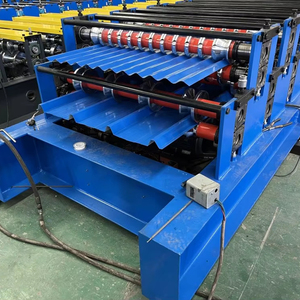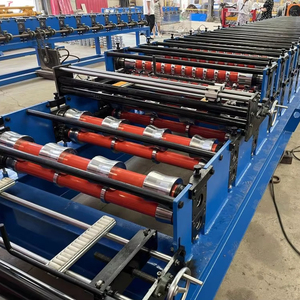Types of C channels roll forming machines
The C channel roll forming machine is used to make C-shaped steel channels, which are structural members used in various building and construction applications to support, brace, panel, or frame. The C-channel roll forming machine is designed to produce C channels in efficient and cost-effective ways. There are generally three types of C-channel machines available:
- Manual C channel rolling machine: A manual C-channel rolling machine comprises three rollers. One is fixed, and the other two are adjustable to form the C-channel. An operator inserts a metal sheet of a particular length and width between the rollers. The dimensions of the channel are altered by adjusting the position of the second and third rollers. Manual machines are small, portable, and straightforward. They can be moved or transported if required, as they are not fixed to any surface. The machine can also be used for small capacities and is not limited to C-channels alone. However, the channel with a manual machine cannot be rolled into a machine precisely. The channels will not have uniformity and accuracy, which may not be ideal for complex projects.
- Machine to roll C channels manually electric: An electric C-channel rolling machine is similar to the manual one in design and operation, but the rolling is done with the assistance of electricity rather than manually. It is a standalone machine and can roll C channels of different sizes with uniformity to some extent. An operator can plug it into an electric socket or generator power. Like the manual version, it lacks precision and accuracy compared to a rolling machine. The C channels formed cannot be used for large constructions that require high standards and specifications. An electric C-channel rolling machine is simple and cost-effective, but like the manual machine, it is limited in size and ability.
- A C-channel roll forming machine: The C-channel roll forming machine has numerous rollers to form various structural sizes and shapes of C-channels with perfection. It works in a continuous manner, making it highly efficient and productive. This machine is best for large constructions that use an extensive number of C-channel pieces. When setting up the machine, a mill form is used to determine the specific shape and size of the C-channel. The machine can then produce the C-channel by feeding the metal sheet through the rollers that are preset according to the shape and size. The process is automated. A computer system controls the rollers, and a decoiler helps to unravel the steel coil smoothly and continuously, which is fed into the roller machine. Using a C-channel roll forming machine is a cost-effective option for businesses that must manufacture large quantities of C-channels by investing in a durable machine that can produce hundreds of different kinds of C-channels efficiently and effectively.
Specifications and maintenance of C channel roll forming machines
Specifications
- Working materials: C channel profile machines can accept a variety of metals and materials as the working supply. Commonly applied metal materials include steel, stainless steel, aluminum alloy, copper, and others.
- Thickness: The thickness of the material the machine can roll ranges from 0.2 to 5.0 mm or more, with custom thickness options available.
- Length: The length of the formed C channel steel can be customized to meet specific project requirements.
- Speed: The forming speed of the machine can be controlled, typically ranging from 10 to 30 meters per minute, or faster.
- Power source: C channel roll forming power sources come in a variety of options, including hydraulic, electric, and pneumatic, depending on specific requirements. For example, electric power is usually 5 kW to 15 kW or more.
- Control system: Modern machines are equipped with computer control systems, such as PLC control, for precise control over parameters like the length, quantity, and speed of the profiles.
Maintenance
- Cleaning: Clean the machine periodically to remove dust and metal shavings. This helps to keep the surface pristine and avoid potential damage.
- Lubrication: Lubricate the machine's moving parts, bearings, gears, etc., regularly to ensure smooth operation and minimal friction with each other.
- Regular checks: Check the machine for loose or worn parts, and promptly tighten or replace those damaged or worn components to prevent malfunctions.
- Electrical system maintenance: Periodically inspect and maintain the electrical system and wiring of the power box to ensure stable electrical connections and avoid electrical failures.
- Machine cover: When not in use, cover the machine with a dustproof cloth or tarpaulin to prevent dust and dirt from entering the interior.
- Operating environment: Keep the work area clean and tidy, and maintain a proper ambient temperature and humidity to avoid corrosion and damage to electrical components due to excessive moisture.
Uses of C Channel Roll Forming Machines
C channel roll forming machines are useful in the construction sector and other industries. Below are some of the uses of C channel roll forming machines:
- Structural Support Elements: C channels are commonly used as beams, lintels, and columns in construction projects. They provide excellent strength-to-weight ratios and structural support for various applications.
- Machine Base and Support Structures: C channels serve as base and support structures for heavy machinery. Roll formed C channels provide stability and rigidity for mounting equipment, vehicles, solar panel structures, shelves, and other mechanical assemblies.
- Brackets and Frames: C channels can be used to easily make brackets and frames for doors, windows, cabinets, and other furniture. When used as an assembly component in cabinets and other furniture, C channels improve the product's structural integrity and lifespan.
- Automotive and Transportation Industry: C channels are commonly used in the automotive and transportation sector as structural elements and reinforcements for trailers, chassis, and vehicle frames.
- Sign Support and Streetlights: C channel roll formed sign supports are used to install traffic signs. When combined with other components, they also make streetlight systems.
- Scaffolding: C channels can be used to make scaffolding structures in the building sector. The scaffolding provides vertical and horizontal support for workers or materials during construction, renovation, or maintenance activities.
How to Choose C Channel Roll Forming Machines
Considering the following parameters can help buyers when selecting suitable C channel roll forming machines for their needs:
- Production requirements: this includes the product's size, shape, quantity, and other specifications that buyers want the machine to meet. First, the machine's suitability should be affirmed by its ability to meet the buyer's production requirements and any potential customization options.
- Quality and reliability: the quality and reliability of the C channel roll forming machine should be examined. A well-formed machine assures the production of quality C channels. Choose machines from manufacturers with a proven track record and positive customer feedback.
- Technology and features: some C channel roll forming machines have extra features and technologies, like CNC control systems, automatic stacking systems, or quick changeover capabilities. These advanced functions can improve production efficiency, accuracy, and convenience, but they may raise the cost of the machine.
- Maintenance and service: an essential aspect of ensuring long-term production success is the availability of technical assistance and maintenance services. Select a provider who offers timely help and comprehensive post-purchase services. Additionally, when necessary, consider the accessibility and cost of replacement parts for the machine.
- Environmental compliance: businesses are increasingly held responsible for environmental protection. Consider whether the machine complies with environmental standards and fuel-saving technologies to lessen the carbon footprint of industrial production.
- Supplier comparison and selection: investigating and comparing several suppliers' machines is the next logical step after choosing one. Choose a supplier who guarantees the product's quality and aftermarket support because the machine's cost and value range from supplier to supplier.
C Channel Roll Forming Machine Q and A
Q: Which material is best suited for C channel roll forming machines?
A: The material best suited for C channel roll forming machines includes galvanized sheet, carbon steel, and aluminum alloy.
Q: What is the price of a C channel roll forming machine?
A: The price of the machine ranges from thousands to millions of dollars depending on factors like type, material of manufacturing, automation, capacity, and customizations.
Q: What are the dimensions of the C channels the machine can make?
A: The dimensions of the C channels that a roll forming machine can make depend on the machine in question. When manufacturing C channels, the width will range from 50mm-400mm, the web height from 20mm-150mm, and the thickness from 2mm-6mm.
Q: How long does it take a C channel roll forming machine to complete one channel?
A: The machine can produce more than 12 C channels in one minute. It spends less than 5 seconds to create one C channel.
Q: Is the machine easy to operate?
A: Yes, the roll forming machine is easy to operate. It comes with a PLC control system that allows the operators to set different parameters based on custom request channels easily. With one set up, the machine can produce C channels for several hours without stopping.

































































































































































































